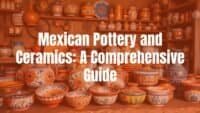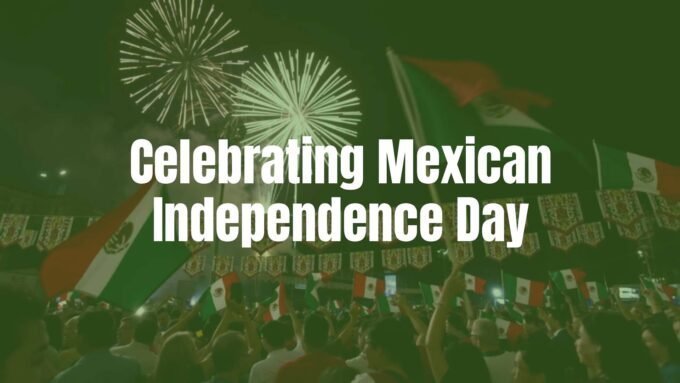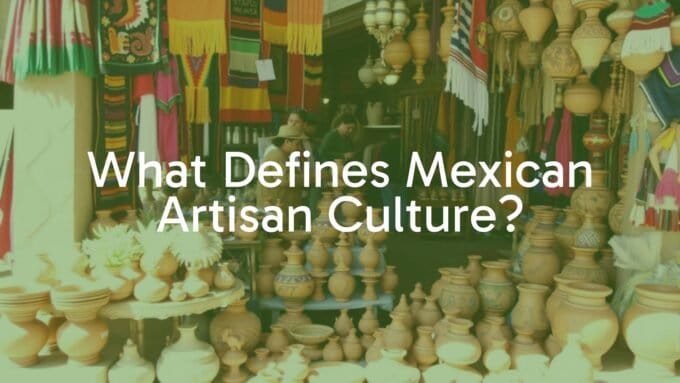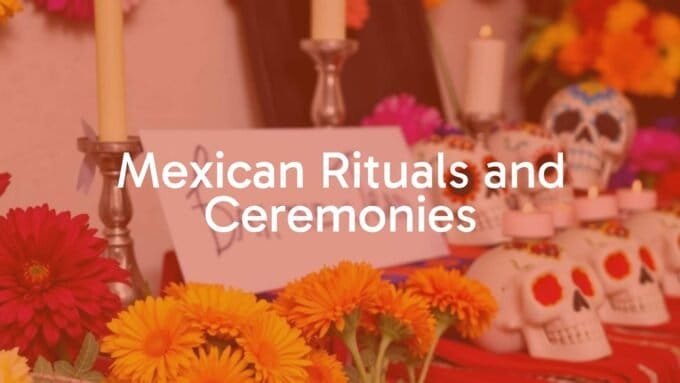Mexican pottery and ceramics are a lively art with roots going back thousands of years. These pieces are more than household items. They carry the country’s history, mixing Indigenous traditions with ideas from abroad. From simple ancient pots to refined modern work, Mexican ceramics tell many stories. Shapes, colors, and brushstrokes show different ways of seeing, and a strong bond with the land and its people.
Pottery in Mexico began long before Europeans arrived, growing with the first Mesoamerican cultures. It is still strong today, adapting to modern tastes while holding tight to old methods and local styles. This article looks at Mexican pottery and ceramics, showing what makes them special, where they come from, how they vary by region, and why they still matter to Mexico’s economy and culture.
What Defines Mexican Pottery and Ceramics?
Mexican pottery is not one style. It is a wide mix of methods, looks, and stories. What ties it together is a long history of skilled work, respect for natural materials, and a natural sense of design that can turn simple clay into lasting beauty. These traits make Mexican ceramics easy to recognize and easy to love.
Key Characteristics of Mexican Pottery Styles
One striking trait is variety. While the human hand and tradition run through it all, each region-and often each maker-adds a special “flavor.” Many styles from pre-Hispanic roots skip glaze and use burnishing, a careful polishing that gives clay a smooth, subtle shine. Designs often include geometric shapes, stylized animals and people, and symbolic or pictograph-like images that echo ancient murals and crafts.
After the Spanish Conquest, new elements arrived, such as colorful majolica glazes and the potter’s wheel. This mix created styles like Talavera, which began in Europe but became Mexican through local patterns and bold colors. Today, many pieces still blend Indigenous and European ideas, making work that is both rich in history and eye-catching. A government-backed “folk art” push also broadened the scene, adding decorative figures and fine wares for local and foreign buyers, often signed by the artist.
Common Materials and Techniques Used in Mexican Ceramics
Mexican pottery starts with local natural clays. Potters often dig the clay themselves or have it brought in. They add temper to reduce cracking during firing. Temper varies by place: cattail fluff in Metepec, sand in Acatlán, kapok in Ameyaltepec, and sometimes feldspar.
Preparing clay takes work. Makers dry and crush chunks-sometimes even letting passing cars do the crushing in Metepec. Another way is to soak clay in water so heavy grit settles, leaving finer material on top. Once ready, pieces are shaped using both old and newer methods. Modeling, coiling, and molding come from pre-Hispanic times and are still common. The wheel, introduced from Europe, is used widely in places like Guanajuato and Jalisco, often as a foot-powered kickwheel or hand-turned wheel. In Oaxaca, Zapotec potters long used a “proto-wheel”: a saucer balanced on an upside-down one, key to the famous barro negro.
Decoration ranges from plain color changes to detailed painting or pressed patterns. While many once made their own colorants, today bought chemicals are common. Firing styles also vary. In the past, firing was often in open fires or pits, usually below 800°C, which could leave pots only partly fired. Some wares, like Fine Orangeware, were exceptions. The spread of closed kilns and higher firing (900-1000°C), often with gas, made more glazes possible, including lead-free ones. Stoneware, which needs even higher heat, came to Mexico in the late 1950s thanks to pioneers like Jorge Wilmot. Today, trained professionals often make stoneware, not just rural makers.
A Brief History of Pottery and Ceramics in Mexico
Mexican pottery reaches back thousands of years, linking ancient peoples with today’s artists. The story is one of change, exchange, and steady work, reflecting the wider history of the country.

Origins and Pre-Columbian Influences
Mexico’s ceramic tradition is ancient, older than the Pre-Columbian period by millennia. In the Purrón period (2300-1500 BCE), earthenware began to replace stone tools. Early clay vessels often copied gourd and squash shapes once used to carry liquids. The Olmec culture, often called the “mother” culture of Mesoamerica, played a key role in early ceramic arts. Sites like Tajín, San Lorenzo, La Venta, and Tres Zapotes show vessels and human-like figures made with simple firing and natural pigments. The Olmecs (about 1500 BC to 800 AD) passed their knowledge on to later cultures.
Before the Spanish, most wares were unglazed. Makers burnished and painted with fine slips. The potter’s wheel was unknown. Pieces were shaped by modeling, coiling, or molding. Simple pinch pots were often made at home, while bigger, complex pieces were made by skilled hands. Molds were common, from pressing clay over existing bowls to using double molds and slip casting for raised designs. Figurines were often mold-made too. Firing was usually in open fires or pits, so temperatures were lower and pots less fully vitrified. Plumbate was the one true glazed Mesoamerican ceramic, made briefly in the Early Postclassic.
Pre-Hispanic pottery showed many ways to decorate: pressing with textiles, stamps, shells, and pointed sticks. Designs were geometric, stylized animal and human forms, symbolic, and pictographic, much like other arts such as murals. All these early methods still appear in modern Mexican pottery, proof of their long life.
Spanish Colonial Era and Its Impact
The Spanish arrival in the 16th century changed ceramics in Mexico. European techniques and looks arrived, reshaping or even replacing some native ways. The central highlands, especially around Mexico City, felt these changes first and most strongly. Pre-Hispanic figurines linked to Indigenous religions faded, replaced by Christian and European themes like the Virgin Mary, angels, and farm animals. Yet many basic forms-comals, molcajetes, basic cooking bowls, and censers-survived much the same, often in plain orangeware with red and black touches.
Big changes included the potter’s wheel, the closed kiln, and lead glazes. Early European-style glazed ware made by native craftspeople was often simple, with green and amber colors and decorations mixing Spanish and Indigenous motifs. Soon, majolica glazed ware took off since importing it from Europe was costly. By the mid-1600s, a strong majolica industry grew, especially in Puebla, known for quality. From about 1650 to 1750 came the “golden age” of Talavera, a Mexican majolica tradition (Talavera Poblana) blending Chinese, Italian, Spanish, and Indigenous methods. By the time of the War of Independence, Mexican majolica was exported across the Americas and even outperformed Spanish versions. In the 1800s, cheaper Delftware and Asian imports cut into its lead.
Modern Developments and Global Recognition
In the 20th century, Mexico adopted styles from France and England and also made major local advances. An important step was the late 1950s arrival of stoneware, led by Jorge Wilmot and Ken Edwards. Stoneware needs higher temperatures and was seen as finer ceramic. In the 1970s, FONART supported it, setting up facilities and training programs that helped create a new group of professional ceramists.
Today, Mexican ceramics range from classic cookware to bold folk sculptures and fine art. Fewer people make pottery now because of cheap factory goods, but folk art and fine ware still play an important role in culture and local incomes. Many modern artists look to old methods and motifs and give them new life. The internet has opened global doors, letting makers sell directly to buyers and collectors. Awards like the Premio Nacional de Cerámica also support quality and new ideas, helping this deep tradition keep growing.
Major Pottery and Ceramic Traditions by Region
Mexico’s many landscapes and cultures have created a wide range of regional styles. Each area, often each town, has a look of its own, shaped by local clay, old techniques, and personal taste. These are living traditions tied to community identity and income.

Oaxaca: Barro Negro and Pre-Hispanic Roots
Oaxaca’s central valleys are a major center for pottery, both utilitarian and decorative. In villages like San Marcos Tlapazola and Vista Hermosa Tonaltepec, Zapotec families make simple, earth-colored cookware and tools. As many men migrate for work, women increasingly make pottery to support their homes, selling in larger towns or through cooperatives.
Two famous Oaxacan traditions are the green-glazed ware of Santa María Atzompa and the barro negro (black clay) of San Bartolo Coyotepec. Barro negro goes back to the Monte Albán period. For centuries it had a matte gray-black look. In the 1950s, Doña Rosa changed the craft by polishing the clay before firing, creating a shiny, metal-like surface that boosted its popularity. Her workshop, now run by her son Valente Nieto Real, still uses this method. Carlomagno Pedro Martinez helped bring barro negro sculpture to global shows. In Atzompa, jade green glaze based on lead monoxide was a hallmark for generations. Rules on lead limited its market, but Dolores Porras created multicolored glazes and later switched to lead-free. The Blanco family, led by Teodora Blanco Núñez, became known for detailed terracotta “muñecas,” decorated with tiny “pastillajes” before firing. Angelica Vasquez Cruz is another key Atzompa artist, known for complex figures of women, mermaids, and angels, often covered with small miniatures and colored with local minerals.
Ocotlán de Morelos is home to the Aguilar sisters, whose mother, Isaura Alcántara Díaz, began a pottery dynasty. Josefina, Guillermina, Irene, Concepción, and Jesús Aguilar became known for bright clay figures of daily life in rural Oaxaca. Much Oaxacan pottery now appeals to high-end folk art buyers and tourists, with cooperatives gaining global attention and support.
Jalisco: Tonalá and Tlaquepaque Pottery
The Guadalajara area is another key center, with Tonalá and Tlaquepaque leading production. They make everything from low-fired pieces to high-fire stoneware.
Tonalá is known for several styles. Bruñido (burnished) is perhaps the best known. These unglazed pieces get a slip and are polished with a stone or pyrite. Often tall-necked jugs or lamp bases, they show stylized animals in gentle tones of rose, gray-blue, and white on light coffee or gray fields. While beautiful, bruñido is usually porous and decorative, except for big tubs for water and special water jars called botellones. Other Tonalá styles include Bandera (green, red, and white, now rare); Petatillo, with dense crosshatching like straw mats and stylized animals; and Canelo, with cinnamon-colored clay, popular for water jugs that keep water cool. Betus pottery uses bright colors and a pine resin oil for a shiny finish. Tonalá also embraced high-fire work through innovators like Jorge Wilmot. The Museo Nacional de la Cerámica (1986) keeps this heritage.
Tlaquepaque, next to Tonalá, shares many traits but has its own specialties. It is known for nativity scenes and other clay figures, often playful and brightly painted. José García Quiñones is noted for unusual nativity scenes. Though factory goods pose competition, Tlaquepaque still makes fine work, including stoneware (El Palomar) and kaolin-type ceramics from Cerámica Contemporánea Suro, which serves high-end clients. The Museo del Premio Nacional de la Cerámica Pantaleón Panduro highlights Mexico’s best ceramics, including winners of the Galardón Presidencial.
Puebla: The Talavera Legacy
Puebla is closely linked with Talavera, a well-known type of majolica with a milky-white glaze and colorful, detailed designs. Real Talavera is tightly regulated and comes only from Puebla city and nearby towns like Atlixco, Cholula, and Tecali, where the right clays are found. Spanish potters brought the tradition in the 1500s. Fine clays and demand for church tiles drove growth, leading to a “golden age” from 1650 to 1750.
Talavera Poblana mixes Chinese, Italian, Spanish, and Indigenous techniques. Cobalt blue on white is classic, but yellow, orange, green, and purple also appear. Making it takes careful, time-consuming work with multiple firings and hand painting. Only a few workshops can legally use the name “Talavera,” and real pieces often have certificates. Talavera Santa Catarina is one certified producer. Most certified Talavera is exported and sold at higher prices, from dish sets to architectural tiles. Puebla also makes cheaper wares like Barrio de la Luz pieces in yellow-brown tones with raised ornaments and clear glazes for the kitchen. In northern Puebla, Nahuatl-speaking makers in Aquixtla and Chignahuapan produce glazed cooking tools with stamped floral designs in traditional Moorish kilns.
Michoacán: Pátzcuaro, Capula, and Indigenous Traditions
Michoacán’s pottery is strong around Lake Pátzcuaro. Tzintzuntzan has many home workshops making wares for tourists. Glazed tableware often shows fish or water birds, with green glaze inside and around the rim, and painted designs on natural clay outside. Burnished black pottery and red-slipped burnished pieces with simple bird motifs also appear. Makers also copy pre-Hispanic forms, such as tripod jars and doughnut-shaped water jugs with geometric designs.
In Santa Fe de la Laguna, potters make glazed ware, often with black or green glaze covering most of the piece, with clear glaze on the rest. Matías Jerónimo is known for large black-glazed bowls with raised leaves. Carmen Gaspar makes tableware with animal or fish designs in white slip under green glaze, and makers are testing new colors like blue and mauve. Patambán is known for fine green-glazed ware with careful glazing, even on the bottoms. Designs range from geometric to animals like rabbits in sharp green over white slip. A well-loved pineapple-shaped water jar with many hand-applied cones appears here and in nearby San José de Gracia. Quiroga makes big black-glazed pitchers and water jugs with relief scenes, often the Danza de los Viejitos; the pottery is formed in Santa Fe and painted in Quiroga. Ocumicho is famous for playful glazed figures of devils and other fantasy scenes; many women are skilled makers there. Capula, near Morelia, is popular for glazed ware with small formal flowers in white slip on red clay under clear glaze. Capula workshops are also trying new designs and using gas kilns and low-lead glazes.
Guanajuato: Mayólica Pottery
Guanajuato has a strong Mayólica tradition that, like Puebla’s Talavera, began in Europe but took on a local character. In colonial times, the city of Guanajuato was a major maker, and that tradition is being revived. Pieces are shaped on the wheel or with tortilla molds for irregular forms. They get a light cream underglaze, are fired, then painted with motifs in yellow, blue-green, rust, and blue, followed by a final glaze and firing. In Guanajuato city, Gorky González makes classic designs; Alfarería Capelo Mayolica makes large pieces in deeper colors. Near Dolores Hidalgo, Alfarería Aguilera Mayolica Santa Rosa shows Indigenous, Italian, and Chinese influences and is run by several Aguilera generations. Dolores Hidalgo, where Father Miguel Hidalgo promoted Mayólica, has many small workshops making tableware, vases, and tiles. Juan Guerrero is known for bold floral designs; his father, Fortino, makes reddish pottery with dripped green glaze and sometimes salamanders. Factories like Bram and Dosa make hand-painted kaolin-type ceramics with modern shapes and pastel flowers. In San Miguel Allende and Coroneo, folk pottery features red-toned bowls with playful, sometimes otherworldly, animal designs in black.
State of Mexico: Metepec and Tree of Life Candelabras
Metepec is the best-known pottery town in the State of Mexico. The town center is full of local work with bold forms and bright colors. Metepec is famous for “Trees of Life” (árboles de la vida): complex multi-branched clay pieces that once showed Bible creation scenes but now include Christmas, Day of the Dead, and many other themes. Sizes range from small to life-size. Makers attach molded figures with wires and paint them in bright colors like pink, green, and yellow, similar to alebrijes. Well-known makers include José Vara, Saúl Ortega, and Alfonso Soteno. Round suns with spiky halos and expressive faces are also popular. Some workshops, like Saul Camacho’s, make Majolica like Puebla’s Talavera, and Manuel León Montes de Oca copies pre-Hispanic pieces. Metepec also makes useful pottery in natural colors with simple geometric designs. A unique item is the pulque pitcher-and-cup sets, sometimes with slogans or animal/human heads from which the drink pours; many are by Lázaro León. Tecomatepec, near Ixtapan de la Sal, also makes pulque vessels and glazed dishes with raised swans or flowers.
Chihuahua: Mata Ortiz Revival
Juan Mata Ortiz in Chihuahua, on the Palanganas River, saw a major pottery revival led by Juan Quezada. This style, also called Paquimé pottery, is inspired by Casas Grandes polychrome ceramics made between 1175 and 1400. At fourteen, Quezada found pottery shards and, after years of self-teaching, learned to recreate the methods. Archaeologist Spencer MacCallum became his mentor and agent, helping bring the work to global attention, including a 1977 Arizona State Museum show.
Unlike other regions, the local pottery line had been lost in colonial times. With no strict old rules to follow, Mata Ortiz makers, taught openly by Quezada, tried many forms and designs. They dig local clay, clean it carefully, and shape pieces without a wheel-molding the base and coiling the top. After drying, pots are polished to a shine and fired on open ground with wood and manure. Paints come from local mineral pigments ground on a metate and applied with animal-hair brushes. Traditional red, white, and earth colors are common, but brighter colors appear too. Today, over three hundred people in Mata Ortiz practice this art, which has changed the local economy. Leading names include the Quezada and Ortiz families (Nicolás Ortiz is known for sculptural pieces), Taurina Baca, and Héctor and Graciella Gallegos.
Other Notable Pottery Regions
Many other areas add to Mexico’s ceramic map. In Chililico, Hidalgo, Nahua women make decorated pieces for ceremonies, mixing old designs with new ideas that often show rural scenes. On the Gulf Coast-Veracruz, Tabasco, Campeche, and Yucatán-centers mainly serve local needs, with strong Indigenous influence since these areas had less European impact. Veracruz includes Blanca Espina, Aguasuelos (large ollas), and Tlacotalpan (porous water coolers). In Tepakán, Campeche, a Maya town makes flowerpots, whistles, and dark brown pitchers for the wind god. Ticul, Yucatán, another Maya town, is skilled at reproducing ancient Maya pieces from Jaina tombs. In Amatenango del Valle, Chiapas, a major workshop area, children make miniature animals while adults-mostly women-create large tinajas with colored slips and dove-shaped flowerpots, firing them on the ground with wood.
Distinguished Types and Styles of Mexican Pottery
The range of Mexican pottery is wide, shaped by local paths, cultural exchange, and personal vision. While every piece carries a bit of Mexico, some types are especially well known for their look and history.
Barro Negro: The Black Clay Tradition
From Oaxaca, especially San Bartolo Coyotepec, barro negro stands out with its black color and glossy shine. Its roots reach back to the Monte Albán period. For most of its life, it had a matte gray-black look. In the 1950s, Doña Rosa began polishing the clay before firing, creating a shiny, obsidian-like surface that brought global attention. The black color comes from reduction firing with low oxygen, which turns the clay dark. Many pieces also have carved designs that add elegance. Artists like Carlomagno Pedro Martinez keep pushing this tradition with new themes and sculptural work.
Majolica and Mayólica Ceramics
Majolica, called Mayólica in Mexico, shows European influence but grew into a Mexican art. This tin-glazed earthenware has an opaque white glaze and arrived with the Spanish in the 1500s. It took root where clay was right, especially in Puebla and Guanajuato. In Puebla, it became Talavera Poblana, a mix of Chinese, Italian, Spanish, and Indigenous styles. Talavera is known for bright colors-often cobalt blue with yellow, orange, green, and purple-on a white base. Guanajuato also built a strong Mayólica scene, with makers like Gorky González and Alfarería Capelo Mayolica. While many use “Majolica” and “Talavera” loosely, Talavera is a specific, regulated type from Puebla. Both are used for tableware and tiles and often serve daily needs as well as decoration.
Polychrome Folk Ceramics
Polychrome folk ware uses many colors, often bold ones. The roots go back to pre-Conquest times, when makers used slips and mineral pigments on burnished, unglazed pieces. After the Conquest, this love of color met European glazes, and color exploded. Examples include Metepec’s bright Trees of Life and animal figures, and Ocumicho’s playful scenes. The Aguilar sisters in Oaxaca paint clay figures of daily life in vivid colors. These works tell stories-religious, cultural, or everyday-and show the joy of color and form. They are a favorite with tourists and collectors.
Functional vs Decorative Pottery
Mexican pottery covers both daily use and art. For a long time, most pieces were tools: comals for tortillas, cazuelas for stews, water and storage jars. These forms, often plain orangeware or local clays, still follow tradition and are common in homes. Some porous clays, like certain bruñido wares, even cool water by design. Many everyday items also look beautiful, with simple designs or a polished finish.
Over time, and with European influence and tourism, decorative work grew. This includes Trees of Life from Metepec and Izúcar de Matamoros, detailed figures by the Blanco family in Atzompa, and ornate Talavera tiles and vases. The folk art movement blurred lines, offering figures, tiles, casseroles, and teacups for local elites and foreign buyers. Now many makers aim for both beauty and use-like painted tableware and burnished vessels that work as centerpieces. The main difference is intent: daily use or display.
Talavera Style: The Iconic Mexican Ceramic Art
Among Mexico’s ceramic traditions, Talavera is the best known. Its special look comes from a rich mix of cultures, and it has become a symbol of Mexican craft around the world.
What Is Talavera Ceramics?
Talavera pottery, or Talavera Poblana, is a tin-glazed earthenware (majolica) known for its bright white glaze and detailed, hand-painted designs. While it takes its name from Talavera de la Reina in Spain, it became its own tradition in Puebla, Mexico. Real Talavera is protected by rules, so only pieces from Puebla and nearby towns like Atlixco, Cholula, and Tecali count as authentic. This is due to the quality of local clay and a steady practice dating to the 1500s.
Talavera blends Arabic methods passed through Spain, Italian Renaissance art, and Indigenous Mexican motifs. This mix shows in its colors and patterns. Potters’ guilds in Mexico once set standards for quality and authenticity. Today, you can see Talavera on building facades and on tableware, and collectors value it worldwide.
How Is Authentic Talavera Produced?
Makers follow a careful, step-by-step process refined over generations. It starts with selecting and preparing local clays. After cleaning and tempering, potters shape the pieces, usually on a wheel, though some forms are molded.
The first main glazing step is a bright white base that gives Talavera its opaque look. After this, the piece is fired in a kiln for the first time. Once cool, artists hand-paint detailed designs-geometric, floral, human, or nature scenes. This stage takes steady hands and training. Cobalt blue is classic, often joined by yellow, orange, green, and purple. After painting, the piece is fired again at high heat. This two-step firing, the use of specific lead-free glazes today, and traditional methods give Talavera its quality and strength. Many pieces break along the way, which adds to the value of finished work.
Talavera Patterns, Colors, and Motifs
Talavera’s look is rich and varied. The most familiar pattern is complex cobalt blue designs on a white base, often compared to Chinese porcelain that passed through Mexico in colonial times and influenced local taste. But the palette also includes yellow, orange, green, and purple, giving it a Mexican feel.
Motifs tell a story of cultural mixing. Traditional designs show stylized flowers, arabesques, and geometric forms from Arabic and Spanish sources. Mexican makers added local birds, animals, and plants. Some pieces even show Europeans, people in Chinese dress, or Indigenous figures, reflecting colonial-era crossings of cultures. This blend gives Talavera lasting charm and makes each piece a small canvas of Mexico’s mixed identity.
Popular and Emerging Mexican Ceramics Brands
While family workshops remain the core of Mexican pottery, newer brands are blending old methods with modern design. They aim to keep heritage alive while fitting current tastes, bringing Mexican ceramics to more people at home and abroad.
ALACHE CERÁMICA
Based in Guadalajara, ALACHE CERÁMICA offers a wide catalog, from stylish plant pots to custom pet bowls. Their look combines traditional craft with a clean, modern feel that fits many homes. You can buy through Instagram DM or email, and in concept stores like Nimia (Guadalajara) and The Happening (Mexico City), reaching buyers who like unique, handmade goods.
SODA CERÁMICA
SODA CERÁMICA adds playfulness and personality. They make delicate-looking vases with unusual shapes and fun English phrases. These pieces work well as statement items or gifts for pottery fans. They respect the handmade process while bringing a light, modern touch that appeals to younger design-minded buyers.
MACETEO
MACETEO turns ordinary planters into charming animal-shaped pots-parrots, axolotls, giraffes, and more. They release small batches, so favorites can sell out fast. Their focus on nature and character makes them a hit with collectors and anyone seeking a cheerful accent for home or garden.
ILA CERÁMICA
ILA CERÁMICA makes bold vases with unusual shapes and refined earth tones. Many pieces feel sculptural, strong enough to stand alone as art. The brand blends traditional techniques with a calm, minimalist design approach, perfect for people who want simple elegance and distinctive forms.
ANFORA
ANFORA is a long-standing name in Mexican ceramics and is sold in big outlets like Pottery Barn, bringing Mexican tableware to a broad market. They focus on classic plates, bowls, and dining pieces. While less indie, they are a dependable choice for bulk orders, including restaurants wanting durable dinnerware with a Mexican touch. In Mexico, buyers can also support smaller Puebla producers for similar traditional pieces. ANFORA remains a key path for sharing Mexican ceramic heritage worldwide through useful, well-made dinnerware.
OAXACAXAMOR
OAXACAXAMOR is an online platform that showcases and sells handmade goods from Oaxaca. It connects local makers with wider buyers, both in Mexico and abroad. The site features ceramics from towns like Atzompa and Tlapazola. If you are in Mexico, buying directly from makers in Oaxaca gives them a larger share of the sale, but OAXACAXAMOR still helps protect and promote these traditions by making them easy to find.
Noteworthy Independent Artisans
Independent artists drive Mexican ceramics forward. In Oaxaca, the Blanco family (from the late Teodora Blanco Núñez) is known for terracotta “muñecas,” with her son Luis García Blanco making “muñecas bordadas.” Angelica Vasquez Cruz of Atzompa creates detailed figures of women, mermaids, and angels. In Ocotlán de Morelos, the Aguilar sisters are famous for painted figures. In Tonalá, Jorge Wilmot helped introduce modern techniques. From Metepec, Óscar Soteno sells elaborate Trees of Life online to buyers around the world. In Chihuahua, the Mata Ortiz revival grew from Juan Quezada’s work and the many makers he trained. Other emerging names-Alumbra Cerámica (delicate decor), Maye Ceramic (elegant homewares), and Encrudo (simple, muted designs)-show that this old craft keeps changing with new ideas.
How Mexican Ceramics Influence Economy and Culture
Mexican ceramics are more than beautiful pieces. They connect to ancient traditions, support many families, and stand as strong symbols of national identity and art.
Economic Contributions and Export Patterns
Ceramics play an important role in Mexico’s economy. While many people think first of handcrafted pots and dishes, most ceramic output is actually floor and wall tiles, followed by bathroom fixtures. The raw materials are mostly local, though some mass-production gear, often from Italy, is imported. In the 1990s, Mexico sent large amounts of ceramic coverings and many bathroom fixtures to the United States, showing strong export ability.
Traditional and artistic ceramics make fewer tons but are key for rural incomes, especially where other jobs are scarce. In places like Oaxaca, craftwork is often the main cash income, offering an alternative to farming or migration. The fastest-growing part of the sector is small firms making handmade tableware and decor, with exports to the United States, parts of Asia, and Europe. Groups like Barro sin Plomo have sent lead-free pottery to the U.S., pointing to good prospects, especially for Mexican restaurants that need safe, authentic tableware. The internet also helps, letting makers like Óscar Soteno sell directly to global customers and tap seasonal markets like Christmas and Halloween (with Day of the Dead themes).
Even so, the number of artisans is dropping because of cheap factory goods and better-paying careers. Many workshops have closed. Also, continued use of lead glazes blocks export for many traditional pieces. Wider use of lead-free glazes would open more doors.
Social and Cultural Significance of Pottery
Ceramics carry deep social and cultural meaning in Mexico. As Art Historian Herbert Read said, “A people’s creativity, its sensitivity and its finesse can all be appreciated through its pottery.” In Mexico, this rings true. Pottery is a living art tied to a 3,000-year line that began with the Olmecs and keeps absorbing new ideas while staying rooted in Indigenous practice.
In many places, pottery is a family craft. Children learn early by shaping small parts, then take on more as they grow. This passing of skill keeps methods alive and strengthens family and community ties. The process often includes beliefs and blessings, along with respect for the clay. The loss of workshops puts pressure on this social fabric, as young people look elsewhere for work.
As art, Mexican ceramics are known for their character and local “flavor.” They mix pre-Hispanic spirituality, European styles, and even Asian touches, telling a visual story of Mexico’s complex past. From sacred pre-Hispanic figures to colonial “Trees of Life” and today’s scenes of daily life, ceramics mirror beliefs, stories, and taste. They are sources of pride, shown in national museums, honored in yearly contests like the Premio Nacional de Cerámica, and loved in homes across Mexico and worldwide. Ongoing interest at home and abroad helps keep these traditions alive.
Collecting and Caring for Mexican Pottery and Ceramics
Collecting Mexican pottery connects you to a deep heritage. To keep pieces beautiful and valuable, learn how to spot the real thing and how to care for it.
Tips for Identifying Authentic Pieces
Finding real Mexican pottery, especially by region, takes some knowledge. Try these tips:
- Know the region: Styles are tied to places. Talavera is only from Puebla and nearby towns; barro negro is from Oaxaca. Learn the traits of the area you like.
- Look for handwork: Handmade pieces often have small irregularities. These signs of the hand add character. Machine-made items look uniform.
- Check glaze and paint: For Talavera, look for a milky-white base and hand-painted designs. Real Talavera uses painted motifs, not stamps. For unglazed burnished pieces, look for the smooth polish and natural clay colors.
- Talavera certification: Real Talavera comes with a stamp or certificate from approved workshops.
- Ask about the process: A good seller or maker can explain clay types, shaping methods (coiled, molded, wheel-thrown), and firing.
- Lead awareness: Many low-fired traditional glazes used lead. Lead-free options exist and are growing, especially for export, but some pieces still contain lead. If you want to use a piece for food, confirm it is lead-free. Some wares marked “sin plomo” have tested positive for lead, so buy from trusted sources.
- Visit workshops: Seeing makers at work-especially on market days in towns like Tonalá-helps you learn and buy directly.
Proper Care and Maintenance Recommendations
Care depends on whether the item is glazed or unglazed, and if it is meant for display or for use with food.
- Decorative unglazed/burnished pieces: Many burnished wares like bruñido are porous and not for liquids or food. Dust with a soft, dry cloth. Avoid water or harsh cleaners. If needed, use a slightly damp cloth lightly, then dry at once.
- Glazed food-safe pottery (Talavera, modern Capula): If certified lead-free and made for food, handwash with mild soap and water. Avoid abrasive pads. Even if some high-fired pieces survive dishwashers, handwashing keeps paint and glaze looking good. Avoid sudden temperature changes, and do not use microwaves or ovens unless the maker says it is safe.
- Older or unknown glazed pieces: If you do not know the lead content, do not use for food. Use as decor or for dry items. If you plan to use it with food, have it tested.
- Handling: Handle gently, especially delicate or detailed work. Avoid bumps and drops. Display in stable spots.
- Sunlight and humidity: Long direct sun can fade colors. Big humidity swings can affect unglazed clay. Keep pieces away from strong heat and moisture.
By learning about your pieces and following these care steps, you can help keep Mexican pottery in great shape for years.
Frequently Asked Questions about Mexican Pottery and Ceramics
Why Is Mexican Pottery So Unique?
It is unique because it blends ancient Indigenous traditions with European and Asian ideas, all seen through Mexican culture. The variety is huge-from burnished pre-Hispanic styles to bright Talavera glazes. Each piece reflects local materials, regional motifs, and the touch of the maker. This deep history, handwork, and bold expression give Mexican pottery character that people value around the world.
Is Talavera Pottery Safe for Food Use?
Modern Talavera from certified Puebla workshops is generally safe for food. These makers follow strict standards and use lead-free glazes. Always make sure you are buying certified Talavera, since imitations and older pieces may contain lead. Ask about lead content and look for certification or a “lead-free” stamp if you plan to use it for food. If there is any doubt, use it as decor only.
How to Recognize Genuine Mexican Ceramics?
Look for these signs:
- Origin: Some styles only come from certain places (Talavera from Puebla, barro negro from Oaxaca).
- Handmade traits: Small irregularities show human touch; factory pieces look uniform.
- Materials and methods: Know if it is burnished or glazed; match designs and colors to known traditions.
- Talavera marks: A milky-white glaze, hand-painted designs, and a certification mark or maker’s signature.
- Trusted sellers: Buy from galleries, cooperatives, or directly from makers who can explain the process and origin.













Leave a comment